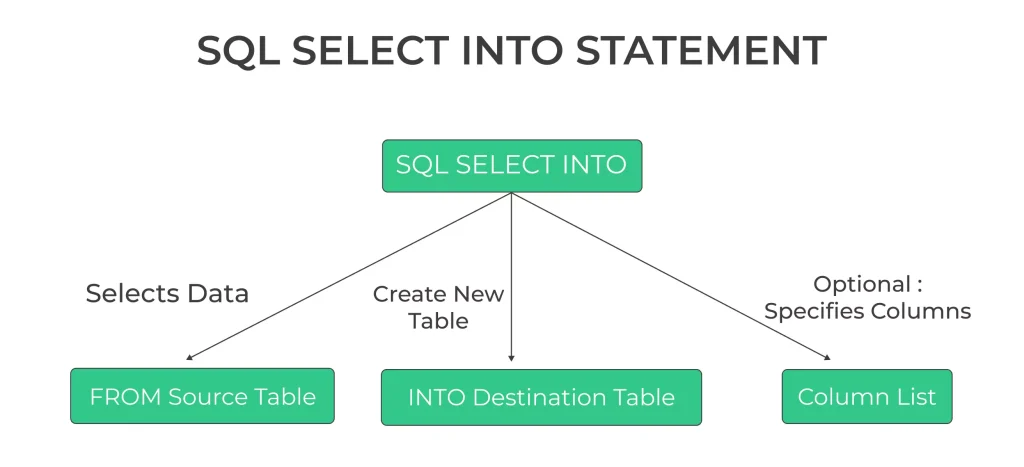SQL SELECT INTO Statement

Introduction to SQL SELECT INTO Statement
SQL (Structured Query Language), the SELECT INTO statement is a powerful tool that allows you to perform various operations with your data.
SQL (Structured Query Language) plays a pivotal role in managing and retrieving data efficiently. One of the most powerful and versatile SQL statements is SELECT INTO.
In this article, we will explore the various aspects of the SELECT INTO statement, exploring its syntax, use cases, and best practices.
Understanding SQL SELECT INTO Statement
SELECT INTO is a SQL statement primarily used for selecting data from one table and inserting it into another table. This operation can be incredibly useful in various scenarios, including data migration, data transformation, and creating backup copies of existing data.
The SELECT INTO statement in SQL is primarily used for two main purposes:
- Creating a New Table: You can use the SELECT INTO statement to create a new table by selecting data from one or more existing tables. This is a valuable feature when you need to organize and store data in a structured manner.
Populating a Table with Results: Another common use of SELECT INTO is to populate an existing table with the results of a query. This can be particularly useful when you want to update or maintain data in an organized fashion.
SQL SELECT INTO Statement Syntax Explained
SELECT column1, column2, ... INTO new_table FROM old_table WHERE condition;
column1, column2, ...:Specifies the columns you want to select from the old table.new_table:Specifies the name of the new table where the selected data will be inserted.old_table:Specifies the name of the old table from which data is selected..condition:An optional clause that allows you to filter the rows to be selected.
Populating an Existing Table with Results
To populate an existing table with the results of a query, you can use the INSERT INTO statement in combination with SELECT:
INSERT INTO existing_table (column1, column2, ...) SELECT column1, column2, ... FROM source_table WHERE condition;

Practical Applications SQL INTO Clause Examples
SELECT * INTO backup_table FROM original_table;
SELECT category, SUM(sales) AS total_sales INTO sales_summary FROM sales_data GROUP BY category;
SELECT employee_name, sales INTO top_employees_report FROM employee_data ORDER BY sales DESC LIMIT 10;
Click below to access free SQL quizzes which will be helpful in your placement exams
SQL SELECT INTO Advanced Techniques
SELECT * INTO high_value_customers FROM customer_data WHERE total_purchases > 10000;
DECLARE @table_name NVARCHAR(255); SET @table_name = 'daily_log_' + CONVERT(NVARCHAR(8), GETDATE(), 112); SELECT * INTO @table_name FROM log_data;
Advantages of SQL SELECT INTO Statements :
Conclusion
SQLSELECT INTO statement, covering its syntax, common use cases, and best practices. By mastering this statement, you can efficiently manage and manipulate data, creating a well-structured and optimized database. Whether you’re a seasoned SQL developer or just starting your journey, the SELECT INTO statement is a valuable tool in your arsenal for efficient data management.
Prime Course Trailer
Related Banners
Get PrepInsta Prime & get Access to all 200+ courses offered by PrepInsta in One Subscription

Question 1.
Can I use SELECT INTO to copy data between databases?
No, SELECT INTO is typically used within the same database. To copy data between databases, you may need to use other methods or tools.

Question 2.
What happens if the target table already exists in the database?
If the target table specified in SELECT INTO already exists, the statement will fail. You should either drop the existing table or choose a different name for the new table.

Question 3.
Is it possible to use SELECT INTO without specifying a WHERE condition?
Yes, it’s possible to use SELECT INTO without a WHERE condition. In such cases, all rows from the old table will be copied to the new table.

Question 4.
Can I select data from multiple tables using SELECT INTO?
No, SELECT INTO is designed to select data from a single table and insert it into another table. If you need to join data from multiple tables, you should use SQL JOIN operations in your query.
Get over 200+ course One Subscription
Courses like AI/ML, Cloud Computing, Ethical Hacking, C, C++, Java, Python, DSA (All Languages), Competitive Coding (All Languages), TCS, Infosys, Wipro, Amazon, DBMS, SQL and others




